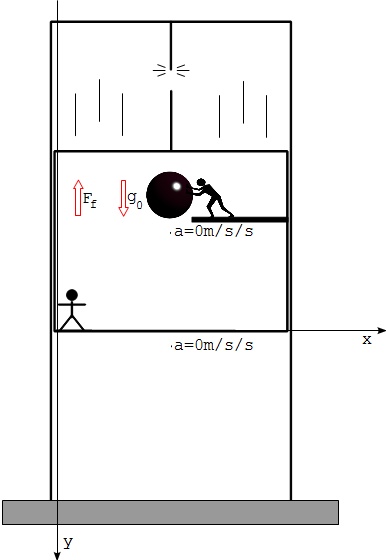Physics Notes - Herong's Tutorial Notes - v3.25, by Herong Yang
Falling Ball in Elevator Frame of Reference
This section provides an example of a falling ball in the elevator frame of reference, where we need to add a fictitious force to cancel out the gravitational force to make Newton's First and Second Laws of Motion valid.
If we change the frame of reference in the example described in the previous section, we will see a new issue in Newton's First and Second Laws of Motion.
Consider the assumptions as described in the previous section. A man with a ball is in an elevator. The elevator cable breaks. The man falls down with the elevator. While falling down, he pushes out ball to try to drop it.
Now we set a frame of reference in the elevator and observer the motion of the ball, we will see the following:
- There is a gravitational force (9.8 newton/kg) in the vertical direction acted by Earth.
- The ball is not down vertically. The vertical acceleration is 0 m/s/s.
So Newton's First and Second Laws of Motion are invalid again. In order to make them valid, we need to introduce a fictitious force (-9.8 newton/kg) associated with the frame of reference. The reason is that the frame of reference has a downward acceleration.
With this fictitious force added to the frame of reference that fixed to the elevator, Newton's First and Second Laws of Motion are valid now: The ball has a downward acceleration (0 m/s/s), because there is no net force in the vertical direction. The downward gravitational force is canceled out by the upward fictitious force.

Table of Contents
Introduction of Frame of Reference
Falling Ball in Earth Frame of Reference
►Falling Ball in Elevator Frame of Reference
Introduction of Special Relativity
Time Dilation in Special Relativity
Length Contraction in Special Relativity
The Relativity of Simultaneity
Minkowski Spacetime and Diagrams
Introduction of Generalized Coordinates